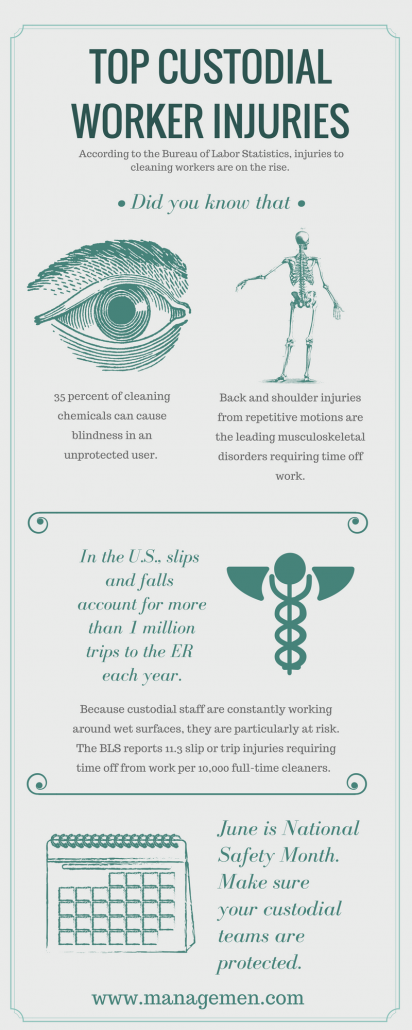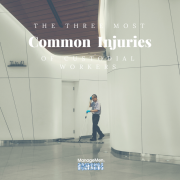Easy Ways You Can Prevent Common Injuries to Custodial Workers [INFOGRAPHIC]
June kicks off National Safety Month, a month dedicated to raising awareness of workplace safety issues. In the custodial services industry, we focus a lot on how we can clean in a way that reduces risks to building occupants. For example, people often ask us the best way to reduce the risk visitors slipping and falling in their facility. We also field a lot of questions about what products and processes people can use to improve their indoor air quality. Each of these questions are important, but they need to happen within a broader conversation about the safety of our custodial operations.
(post continues below)
 When we talk safety, a key focus should be on the safety of the people who clean our buildings. Unfortunately, we’ve found that’s not a focus in enough businesses. According to the most recent data available from the Bureau of Labor Statistics, the incidence rates of injuries and illnesses to janitors and cleaners actually increased to 657 cases per 10,000 full-time workers in 2015, up from 434 cases in 2014. The National Safety Council reports that more than 46,000 cleaners and janitors are injured severely enough each year to require one or more days away from work.
When we talk safety, a key focus should be on the safety of the people who clean our buildings. Unfortunately, we’ve found that’s not a focus in enough businesses. According to the most recent data available from the Bureau of Labor Statistics, the incidence rates of injuries and illnesses to janitors and cleaners actually increased to 657 cases per 10,000 full-time workers in 2015, up from 434 cases in 2014. The National Safety Council reports that more than 46,000 cleaners and janitors are injured severely enough each year to require one or more days away from work.
Custodial workers are on the front lines of battling dirt, but with the dirt comes bacteria, viruses and too often, physical injury. When a custodial worker is sick or injured, it can present a major setback to both the worker and the employer. Cleaning workers often hold more than one job to support their families, so in addition to the pain and suffering from the injury, they may also experience financial hardships.
Employers incur costs from workers’ compensation claims, replacement labor and other soft costs resulting from issues such as reduced morale and productivity amongst other staff members. For a top injury like musculoskeletal disorders, OSHA estimates it costs employers up to $15 billion to $20 billion annually.
At ManageMen, we believe that every worker has the right to go home safely every day and we’ve worked hard to create a system that promotes worker safety.
So what are three of the most common injuries to custodial workers and how can you help prevent them?
- Musculoskeletal disorders: Back injuries (about 46 percent) and shoulder injuries (about 15 percent) were the leading musculoskeletal disorder-causing injuries requiring time off work for janitors and cleaners in 2010, according to BLS. One way to reduce the risk of this type of injury is by promoting a warm up program for your custodial team, as we discussed in this blog post.
- Respiratory issues or burns: Improper handling of chemicals—either by mixing the wrong chemicals together or improperly diluting chemicals—can result in respiratory issues or burns. Janitors also face increased risk from exposure to bloodborne pathogens. The BLS reports 15.7 incidents requiring time off from work per 10,000 full-time janitors and cleaners. By educating workers on the proper ways to handle chemicals and limit their exposure, you can substantially reduce their risk. We have a big announcement around this in the next few weeks, so stay tuned!
- Slips and Falls: When your work focuses on cleaning up the spills other people make, slips and falls are an inevitable workplace hazard. The BLS reports 11.3 slip or trip injuries requiring time off from work per 10,000 full-time janitors and cleaners. Help protect your workers by ensuring they have the proper footwear and have adequate time for floor cleaning tasks to reduce the opportunity for injuries from rushing.
By focusing on these top injury areas and reducing risks, you can help improve the safety and well-being of your hard-working custodial staff.
Let’s make June a month where we make custodial worker safety a priority. Tell us, what are you planning for Safety Month?



